A high-end 16-inch business laptop, the ThinkPad X1 Extreme G4 is the non-workstation version of the ThinkPad P1 G4. Unless you need that model’s Xeon CPU, ECC memory, Nvidia RTX A-class workstation graphics, or ISV certifications, the ThinkPad X1 Extreme G4 is a more economical option and still offers a high level of performance.
Lenovo ThinkPad X1 Extreme G4 Specifications
The ThinkPad X1 Extreme G4 offers a much greater level of performance than a normal 16-inch business laptop. Powering it is Intel’s 45-watt “Tiger Lake-H” CPUs, which scale to the eight-core Core i9-11950H (5GHz Turbo Boost). It also supports up to 64GB of RAM and two PCI Express Gen 4 SSDs.
The base model comes with integrated Intel UHD graphics, but you can get all the way up to the gaming-grade Nvidia RTX 3080 Max-Q. Overall, it’s an impressive loadout. Getting more performance will mean resorting to a thicker and heavier gaming or workstation laptop, such as the Lenovo ThinkPad P15.
The ThinkPad X1 Extreme G4’s full specifications are as follows.
| Processor | Up to Intel Core i9-11950H (8 cores/16 threads, up to 5GHz Turbo Boost) |
| Operating System |
|
| Display |
|
| Memory | Up to 64GB DDR4-3200 non-ECC |
| Storage | Up to 2TB M.2 2280 PCIe NVMe Gen4 SSD |
| Graphics |
|
| Security |
|
| Audio |
|
| Camera |
|
| Dimensions (HWD) | Starting at: 17.7mm x 359.5mm x 253.8mm / 0.70″ x 14.13″ x 9.99″ |
| Weight | Starting at 1.81kg / 3.99lbs |
| Connectivity |
|
| Ports/Slots |
|
| Keyboard |
|
| Green Certifications |
|
| What’s in the Box |
|
Lenovo ThinkPad X1 Extreme G4 Build and Design
Save for lid and palm rest branding, the ThinkPad X1 Extreme G4 is identical to the ThinkPad P1 G4, so I won’t restate much of what was said in that review. In short, the ThinkPad X1 Extreme G4 is very well made and surprisingly portable, given it uses a 16-inch display. The laptop measures 0.70″ x 14.13″ x 9.99″ (HWD) and has a starting weight of 3.99 pounds.
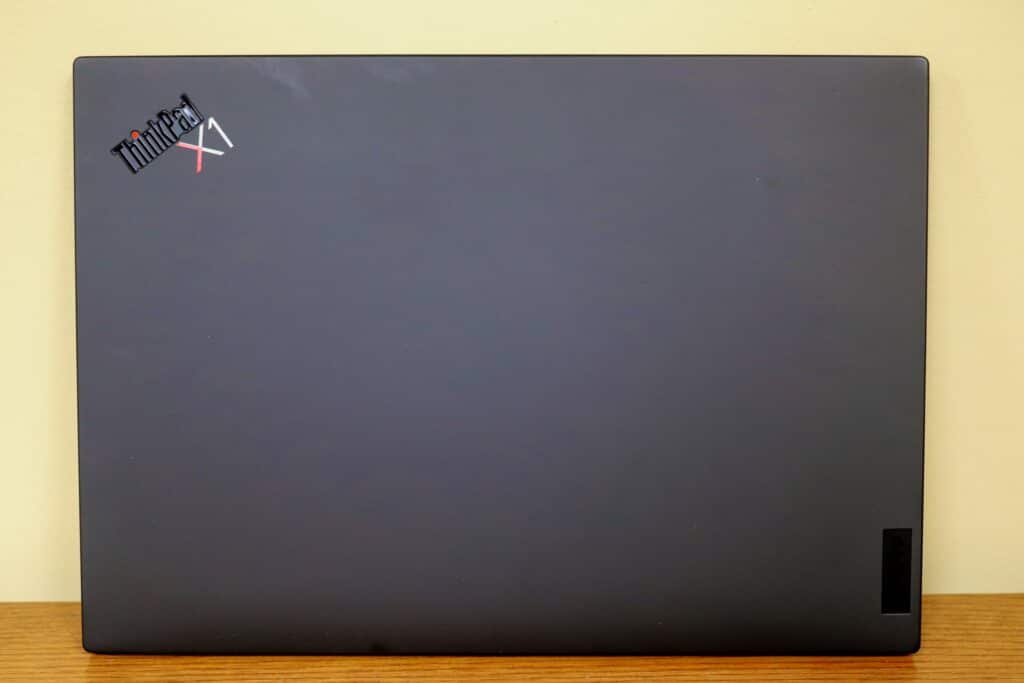
Our review model’s 16-inch display has the standard 2560×1600 resolution, an ample 400-nit brightness rating, and an anti-glare surface. A 3840×2400 screen is offered with touch and higher 600-nit brightness.
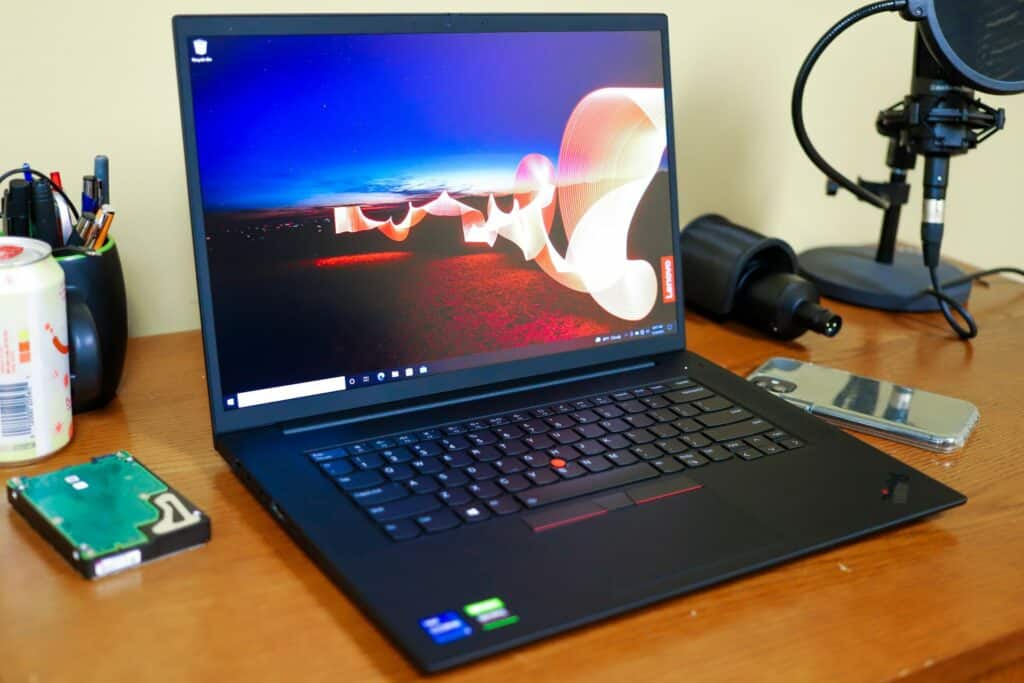
As is expected from a ThinkPad, the keyboard, UltraNav pointing solution, and touchpad all provide excellent tactile feedback. The keyboard has white backlighting.


The ThinkPad X1 Extreme G4 provides good connectivity, including two Thunderbolt 4 (USB-C) ports, two USB-A 3.2 Gen 1 ports, HDMI 2.1 video output, a full-size SD card reader, and a headset jack. WWAN-equipped models also include a SIM card slot. Standard wireless connectivity comes from an Intel AX210 card supporting Wi-Fi 6E and Bluetooth 5.
(The images below are of the ThinkPad P1 G4, which is largely the same laptop as I noted.)
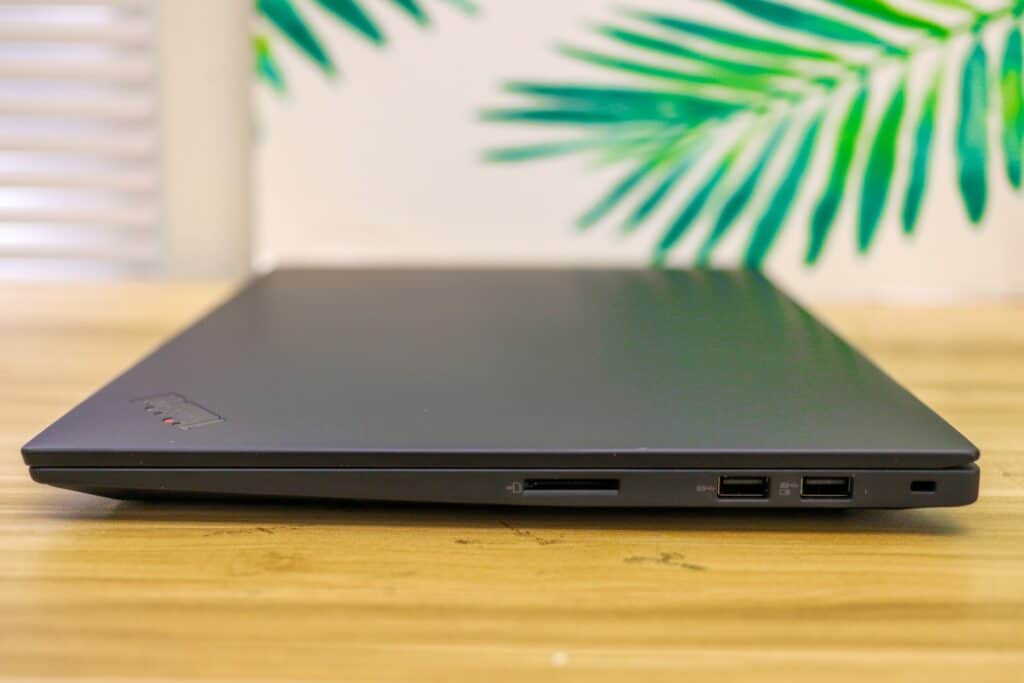
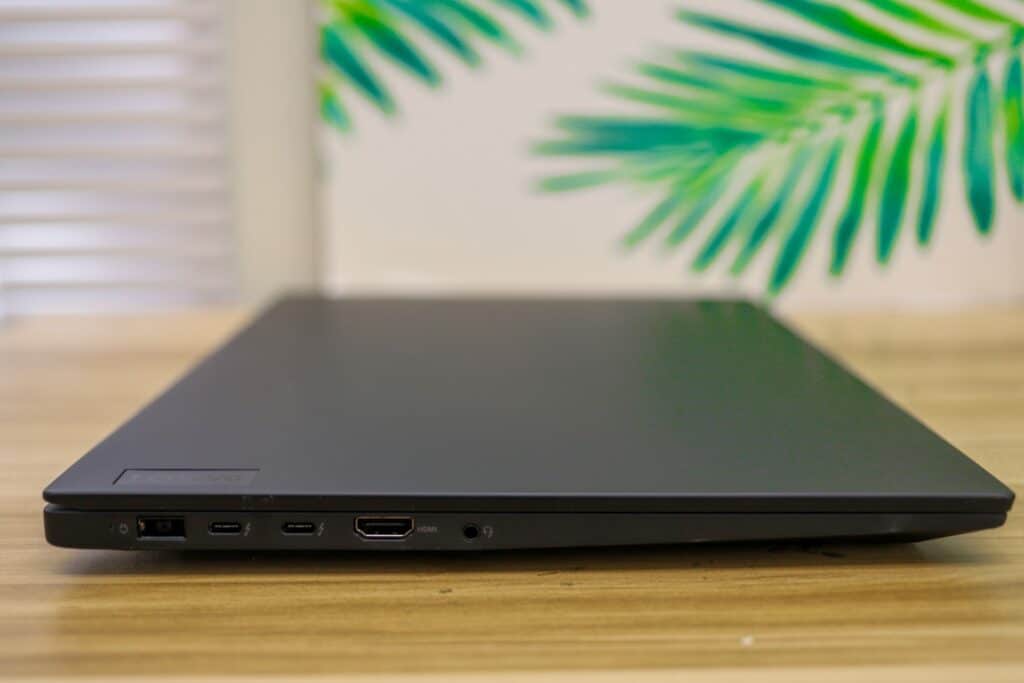
Physical security features include a Kensington cable-lock slot and za webcam privacy shutter. The webcam over the display has a sharp 1080p resolution. An IR camera for facial recognition is optional. A fingerprint reader, which doubles with the power button, is standard.
Lenovo ThinkPad X1 Extreme G4 Performance
Our review unit has the following specifications:
- Lenovo part number 20Y50016US
- 16-inch non-touch display (2560×1600)
- Intel Core i7-11800H 8-core/16-thread CPU (2.3GHz base, 4.6GHz Turbo Boost)
- Windows 10 Pro
- Nvidia GeForce RTX 3060 Max-Q (6GB)
- 16GB DDR4-3200 dual-channel RAM
- 512GB PCIe Gen4 SSD
- Intel Wi-Fi 6E AX210 wireless card w/ Bluetooth 5
- 3-year warranty
- Price: $2,458
This configuration is well-balanced, pairing the base eight-core Core i7 CPU (even the pricey Core i9 CPUs are still eight-core) with the mid-tier GeForce RTX 3060. You could save money by going with an integrated GPU-only model unless you’re gaming, video editing, or doing complex 3D work.
The RAM and storage are upgradeable by removing the bottom panel, under which you’ll find the two SoDIMM slots, the M.2 SSD slot, the wireless card, and the battery. It’s a fair level of upgradeability for a modern laptop. This image is from the ThinkPad P1 G4.
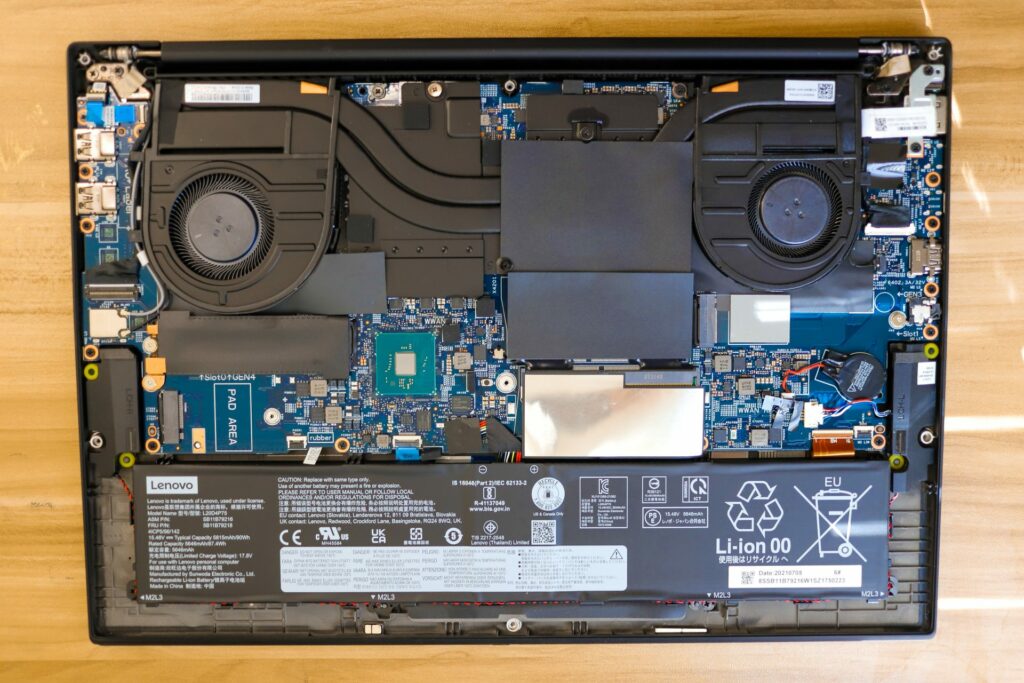
For testing, we will be comparing the ThinkPad X1 Extreme G4 to its counterpart, the ThinkPad P1 G4, which we tested with a six-core Xeon W-11855M CPU, a 4GB Nvidia RTX A2000 graphics card, 64GB of memory, and a 2TB PCI Express Gen 4 SSD. The six- versus eight-core CPU will be an intriguing matchup, as will the GeForce RTX 3060 versus the RTX A2000. The memory and storage differences shouldn’t have a large impact for the tests we run.
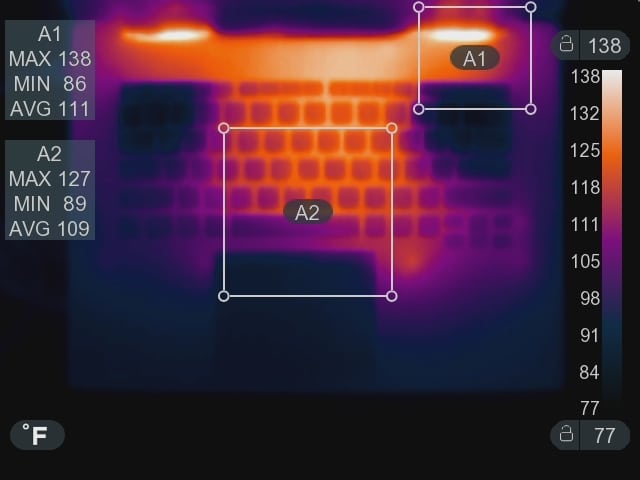
After a long endurance run with heavy GPU usage, we measured took a thermal photo of the X1 Extreme Pro G4 and found it to handle itself pretty well. Heat is exhausted through vents ejecting hot air behind the open display. Here we measured a peak of 138F, with the keyboard staying cooler. The keyboard and touchpad by comparison measured a peak of 127F, with an average of 109F.
SPECviewperf 2020
Our first test is SPECviewperf 2020, the worldwide standard for measuring graphics performance of professional applications under the OpenGL and Direct X application programming interfaces. The viewsets (or benchmarks) represent graphics content and behavior from actual applications, without having to install the applications themselves. The newest version of this benchmark went through major updates late last year, including new viewsets taken from traces of the latest versions of 3ds Max, Catia, Maya, and Solidworks applications. In addition, they added support within all viewsets for both 2K and 4K resolution displays.
The ThinkPad X1 Extreme and the P1 performed closely in several viewsets, including 3dsmax-07, Catia-06, Maya-06, and Sw-05. However, the P1’s RTX A2000 has far better optimized GPU drivers for the other tests, especially Creo-03, Energy-03, and Snx-04, which allowed it to lead.
| SPECviewperf 2020 (Higher is better) | ||
| Viewsets | Lenovo ThinkPad X1 Extreme G4 (2560×1600, Nvidia RTX 3060) | Lenovo ThinkPad P1 G4 (2560×1600, Nvidia RTX A2000) |
| 3dsmax-07 | 68.37 | 61.98 |
| Catia-06 | 46.42 | 58.09 |
| Creo-03 | 77.2 | 103.73 |
| Energy-03 | 18.67 | 31.02 |
| Maya-06 | 203.96 | 237.75 |
| Medical-03 | 24.19 | 32.22 |
| Snx-04 | 26.28 | 368.11 |
| Sw-05 | 150.98 | 146.57 |
SPECworkstation 3
SPECworkstation3 specializes in benchmarks designed for testing all key aspects of workstation performance; it uses over 30 workloads to test CPU, graphics, I/O, and memory bandwidth. The workloads fall into broader categories such as Media and Entertainment, Financial Services, Product Development, Energy, Life Sciences, and General Operations. We are going to list the broad-category results for each, as opposed to the individual workloads. The results are an average of all the individual workloads in each category.
The ThinkPad X1 Extreme and the P1 split these tests. The X1 Extreme did far better in GPU Compute, which uses raw GPU power, showing that its GeForce RTX 3060 has more muscle than the P1’s RTX A2000.
| Lenovo ThinkPad X1 Extreme G4 (2560×1600, Nvidia RTX 3060) | Lenovo ThinkPad P1 G4 (2560×1600, Nvidia RTX A2000) | |
| M&E | 2.56 | 2.34 |
| ProdDev | 2.19 | 2.75 |
| LifeSci | 2.08 | 2.33 |
| Energy | 1.27 | N/A |
| FSI | 2.27 | 1.75 |
| GeneralOps | N/A | 2.37 |
| GPU Compute | 4.43 | 2.87 |
ESRI
Next up is the Environmental Systems Research Institute (Esri) benchmark. Esri is a supplier of Geographic Information System (GIS) software. Esri’s Performance Team designed their PerfTool add-in scripts to automatically launch the ArcGIS Pro. This application uses a “ZoomToBookmarks” function to browse various predefined bookmarks and create a log file with all the key data points required to predict the user experience. The script automatically loops the bookmarks three times to account for caching (memory and disk cache). In other words, this benchmark simulates heavy graphical use that one might see through Esri’s ArcGIS Pro software.
The tests consist of three main datasets. Two are 3-D city views of Philadelphia, PA, and Montreal, QC. These city views contain textured 3-D multipatch buildings draped on a terrain model and draped aerial images. The third dataset is a 2-D map view of the Portland, OR region. This data contains detailed information for roads, land use parcels, parks and schools, rivers, lakes, and hill shaded terrain.
The ThinkPad P1 outperformed the ThinkPad X1 Extreme in all three tests, an advantage again attributable to its optimized Nvidia RTX A2000 GPU drivers. The X1 Extreme’s consumer-grade GeForce RTX 3060 isn’t ideal for these tasks, but is nonetheless capable.
| ESRI ArcGIS Pro 2.3 Montreal | |
| Average FPS | Average |
| Lenovo ThinkPad X1 Extreme G4 (2560×1600, Nvidia RTX 3060) | 117.5 |
| Lenovo ThinkPad P1 G4 (2560×1600, Nvidia RTX A2000) | 266.32 |
| Minimum FPS | Average |
| Lenovo ThinkPad X1 Extreme G4 (2560×1600, Nvidia RTX 3060) | 45.7 |
| Lenovo ThinkPad P1 G4 (2560×1600, Nvidia RTX A2000) | 118.05 |
| ESRI ArcGIS Pro 2.3 Philly | |
| Average FPS | Average |
| Lenovo ThinkPad X1 Extreme G4 (2560×1600, Nvidia RTX 3060) | 112.6 |
| Lenovo ThinkPad P1 G4 (2560×1600, Nvidia RTX A2000) | 182.46 |
| Minimum FPS | Average |
| Lenovo ThinkPad X1 Extreme G4 (2560×1600, Nvidia RTX 3060) | 50.41 |
| Lenovo ThinkPad P1 G4 (2560×1600, Nvidia RTX A2000) | 109.6 |
| ESRI ArcGIS Pro 2.3 Portland | |
| Average FPS | Average |
| Lenovo ThinkPad X1 Extreme G4 (2560×1600, Nvidia RTX 3060) | 183.6 |
| Lenovo ThinkPad P1 G4 (2560×1600, Nvidia RTX A2000) | 2134.4 |
| Minimum FPS | Average |
| Lenovo ThinkPad X1 Extreme G4 (2560×1600, Nvidia RTX 3060) | 131.8 |
| Lenovo ThinkPad P1 G4 (2560×1600, Nvidia RTX A2000) | 628.8 |
LuxMark
LuxMark is an OpenCL cross-platform benchmarking tool from those who maintain the open-source 3D rending engine, LuxRender. This tool looks at GPU performance in the areas of 3D modeling, lighting, and video work. For this review, we used the newest version, v4alpha0. In LuxMark, higher is better when it comes to the score.
Like the GPU Compute test in SPECworkstation 3, this test doesn’t require specialized GPU drivers for maximum performance, instead focusing on raw GPU power, and so the X1 Extreme easily pulled ahead.
| Benchmark | Lenovo ThinkPad X1 Extreme G4 (2560×1600, Nvidia RTX 3060) | Lenovo ThinkPad P1 G4 (2560×1600, Nvidia RTX A2000) |
| Food | 3679 | 2148 |
| Hall | 9929 | 6079 |
Blender OptiX
Next up is Blender, an open-source 3D modeling application. This benchmark was run using the Blender Benchmark utility. NVIDIA OptiX was the chosen render method. The score is in seconds, with lower being better.
This test also rewards GPU performance over driver optimization. The X1 Extreme was the clear winner.
| Blender OptiX, rendering time in seconds (lower is better) | ||
| Category | Lenovo ThinkPad X1 Extreme G4 (2560×1600, Nvidia RTX 3060) | Lenovo ThinkPad P1 G4 (2560×1600, Nvidia RTX A2000) |
| bmw27 | 24.3 | 46.31 |
| classroom | 93.14 | 148.74 |
| fishy_cat | 53.55 | 88.93 |
| koro | 116.67 | 175.80 |
| pavilion_barcelona | 120.03 | 208.57 |
Octane
Last, we look OctaneBench, a benchmarking utility for OctaneRender, which is another 3D renderer with RTX support that is similar to V-Ray. The ThinkPad X1 Extreme G4 completed this with a score of 309.46, much better than the score of 168.49 that we recorded from the ThinkPad P1 G4. Its GeForce RTX 3060 gave the X1 Extreme the edge, as it did in many prior tests that didn’t depend on driver optimization.
Conclusion
The Lenovo ThinkPad X1 Extreme G4 is a powerful and versatile 16-inch business laptop. Its high screen resolution, excellent input devices, and top-notch build quality make for excellent productivity. Performance-wise, it’s capable of demanding tasks like video editing, thanks to its available eight-core CPU, up to 64GB of RAM, two SSDs, and a dedicated Nvidia GPU. Lenovo also offers this laptop as the ThinkPad P1 G4 should you require workstation features. Its top-tier pricing is easier to swallow considering how few compromises it makes. Overall, the ThinkPad X1 Extreme G4 comes highly recommended.




 Amazon
Amazon